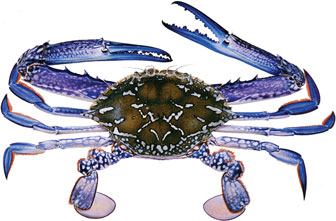
Blue swimmer crabs are sometimes called ‘blue manna’ or ‘blueys’. They are powerful swimmers and voracious hunters and scavengers. They are targeted by commercial and recreational fishers.
Blue swimmer crabs (Portunus armatus; formerly known as P. pelagicus) are a tropical species and belong to the Portunidae family. The family also includes other large, edible crabs found in Australia, such as mud crabs.
Crabs from this family can usually be recognised by their flat, disc-shaped hind legs, used as paddles for swimming. They also have nine spikes, called horns, along their carapace, on either side of their eyes.
In Western Australia, blue swimmer crabs can grow to up to 25 cm wide across the carapace with a claw span of up to 80 cm. They eat small fish and crustaceans, molluscs, worms, and occasionally, algae and seagrass. In turn, they are prey for fish and birds.
Distribution and habitat
In WA they’re found mainly between Port Hedland and Dunsborough. They live in estuaries, sheltered bays and offshore waters up to 50 m deep.
Estuarine crabs tend to move from estuaries into nearby marine waters during winter. Crabs in marine bays spend their entire lives in the bay.
By day, they usually hide beneath the sand with only their eyes protruding, then launch themselves at prey. At night they become mobile and search for food.
Lifecycle
Blue swimmer crabs begin life as tiny larvae, called ‘zoea’, which grow and change shape over a four-to-six-week period during early summer. They drift in bays or along the coast up to 80 kilometres out to sea. They are prey for fish and the death rate is high.
The survivors reach shallow nursery areas by late summer. They settle to the sea or estuary bottom and moult (shed their shell) frequently while rapidly growing. They turn into a more crab-like state called ‘megalopae’. By autumn, most are crab-shaped. They continue growing rapidly.
By winter, the carapace is about nine centimetres wide. During the final moult to reach maturity, females mate for the first time. Most mating takes place in the autumn. Males moult first, so that their new shells have hardened beforehand. A courting male then catches a female and carries her beneath him for four to 10 days while fending off other males. He helps her to moult then turns her over to mate while she is still soft-shelled. After mating, he continues to carry and protect her for another three-to-four days while her new shell hardens. In southern WA waters, the females retain the males’ sperm over winter until their ovaries develop – helped, it’s thought, by rising water temperature in spring.
In the ocean, big females mostly spawn in late spring and early summer. Estuarine crabs tend to spawn later in summer, having moved to the sea or estuary mouth during winter rains. Each female produces between 180,000 and two million eggs in a single spawning – and may spawn more than once in a season.
The eggs are fertilised by the stored sperm and, when laid, they attach under the female’s abdomen, forming a spongy mass. The term for a female crab carrying egg clusters is ‘berried’. The female incubates the eggs for about 18 days. When the embryos inside are mature she shakes the eggs off and they hatch into zoea. A new life cycle has begun.
More information
For more information see our  Blue swimmer crab fact sheet or
Blue swimmer crab fact sheet or  catch the stats on recreational fishing for blue swimmers.
catch the stats on recreational fishing for blue swimmers.
How to clean blue swimmer crabs to avoid toxic poisoning.
For crabbing rules visit our Recreational fishing guides page or the online rules website.
Illustration © R. Swainston/www.anima.net.au